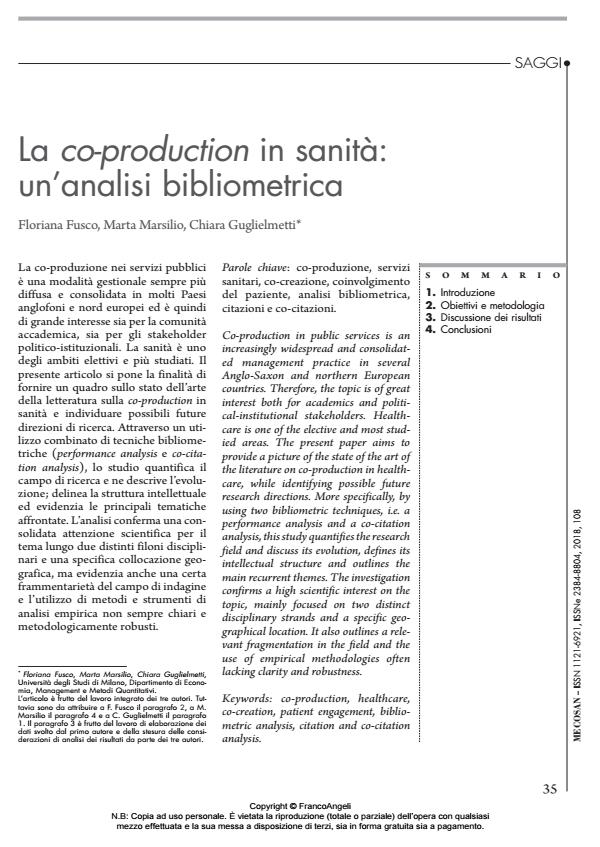La co-production in sanità: un’analisi bibliometrica
Titolo Rivista MECOSAN
Autori/Curatori Floriana Fusco, Marta Marsilio, Chiara Guglielmetti
Anno di pubblicazione 2019 Fascicolo 2018/108
Lingua Italiano Numero pagine 20 P. 35-54 Dimensione file 1047 KB
DOI 10.3280/MESA2018-108003
Il DOI è il codice a barre della proprietà intellettuale: per saperne di più
clicca qui
Qui sotto puoi vedere in anteprima la prima pagina di questo articolo.
Se questo articolo ti interessa, lo puoi acquistare (e scaricare in formato pdf) seguendo le facili indicazioni per acquistare il download credit. Acquista Download Credits per scaricare questo Articolo in formato PDF

FrancoAngeli è membro della Publishers International Linking Association, Inc (PILA)associazione indipendente e non profit per facilitare (attraverso i servizi tecnologici implementati da CrossRef.org) l’accesso degli studiosi ai contenuti digitali nelle pubblicazioni professionali e scientifiche
La co-produzione nei servizi pubblici e una modalita gestionale sempre piu diffusa e consolidata in molti Paesi anglofoni e nord europei ed e quindi di grande interesse sia per la comunita accademica, sia per gli stakeholder politico-istituzionali. La sanita e uno degli ambiti elettivi e piu studiati. Il presente articolo si pone la finalita di fornire un quadro sullo stato dell’arte della letteratura sulla co-production in sanita e individuare possibili future direzioni di ricerca. Attraverso un utilizzo combinato di tecniche bibliometriche (performance analysis e co-citation analysis), lo studio quantifica il campo di ricerca e ne descrive l’evoluzione; delinea la struttura intellettuale ed evidenzia le principali tematiche affrontate. L’analisi conferma una consolidata attenzione scientifica per il tema lungo due distinti filoni disciplinari e una specifica collocazione geografica, ma evidenzia anche una certa frammentarieta del campo di indagine e l’utilizzo di metodi e strumenti di analisi empirica non sempre chiari e metodologicamente robusti.
Parole chiave:Co-produzione, servizi sanitari, co-creazione, coinvolgimento del paziente, analisi bibliometrica, citazioni e co-citazioni
- Il ruolo della telemedicina nella gestione delle liste di attesa e nell'ampliare l'accesso a prestazioni di specialistica ambulatoriale. L'esperienza nella Regione Veneto Cecilia Menegon, Luca Del Bene, in MECOSAN 130/2025 pp.69
DOI: 10.3280/mesa2024-130oa18960
Floriana Fusco, Marta Marsilio, Chiara Guglielmetti, La co-production in sanità: un’analisi bibliometrica in "MECOSAN" 108/2018, pp 35-54, DOI: 10.3280/MESA2018-108003